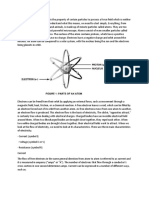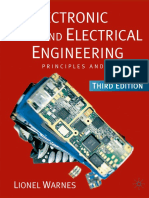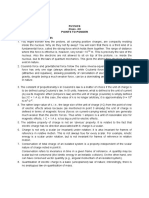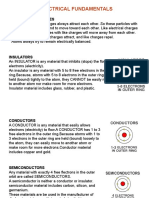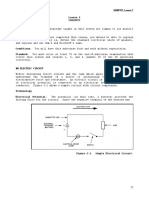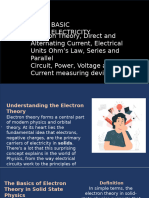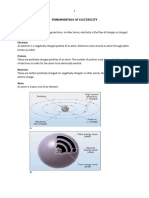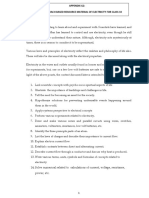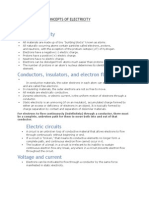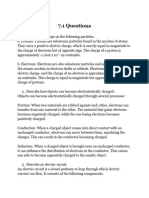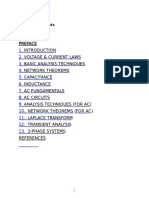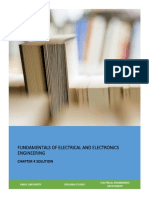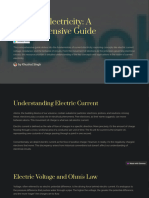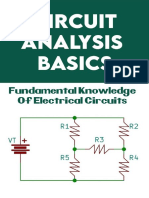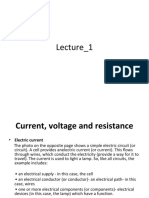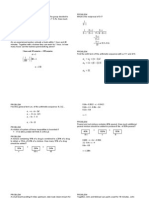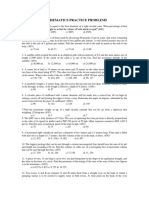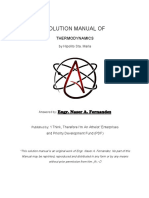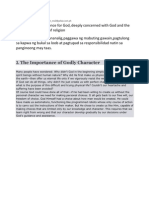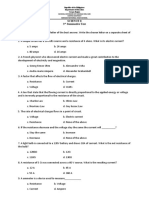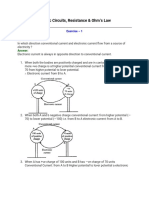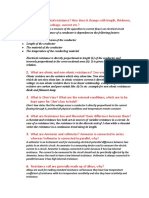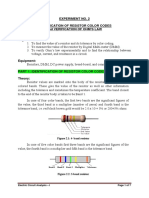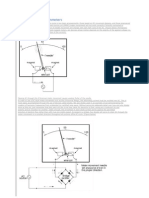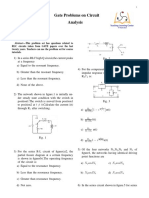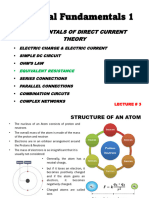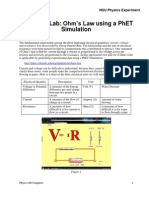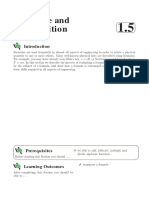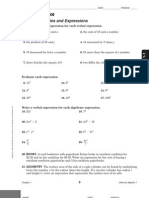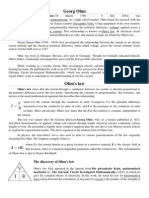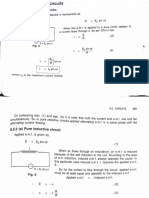PHYSICS2L/Exp. No. 1/page 2
PHYSICS2L/Exp. No. 1/page 2
Uploaded by
Aldrin Kenneth AllanigueCopyright:
Available Formats
PHYSICS2L/Exp. No. 1/page 2
PHYSICS2L/Exp. No. 1/page 2
Uploaded by
Aldrin Kenneth AllanigueOriginal Title
Copyright
Available Formats
Share this document
Did you find this document useful?
Is this content inappropriate?
Copyright:
Available Formats
PHYSICS2L/Exp. No. 1/page 2
PHYSICS2L/Exp. No. 1/page 2
Uploaded by
Aldrin Kenneth AllanigueCopyright:
Available Formats
PHYSICS2L/Exp. No.
1/Page 2
INTRODUCTION In the field of engineering especially electrical and electronics, study of electric circuits is so pervasive. As engineers, it is crucial that we know how to analyze systems containing several electric components. It is important to note that the experimental analysis of electric circuits requires the fabrication and measurement of several parameters (e.g., voltage, current, resistance). For this particular experiment, we were introduced to some of the basic and electrical measuring instruments. One of the instruments essential in the study of electric circuits is the voltmeter, ammeter and multitester which usually combines several measurement functions in one unit. The typical multitester is capable of measuring voltage, current and resistance. It is in a digital form. Digital meters are widely used in experiments due to its efficiency and precision. Analog meters, on the other hand provide students an intuitive knowledge on the fundamental concepts of electric circuits. In analyzing basic electric circuits, it is important to have a basic knowledge in measuring parameters such as current, voltage and resistance. A voltmeter for example should be connected in parallel with the component to measure the voltage across it. Resistance is measured by connecting the test probes of the multitester across the resistor. When measuring current, the ammeter should be connected in series with the component to measure the current through it. Were going to state the OHMS LAW which is used to relate current to resistance and voltage. Probably the most important mathematical relationship between voltage, current and resistance in electricity is something called Ohms Law (Ohm's Law is used to describe the mathematical relationship between voltage, current, and resistance.) Ohm's Law tells us that the electrical current in a circuit can be calculated by dividing the voltage by the resistance. In other words, the current is directly proportional to the voltage and inversely proportional to the resistance. So, an increase in the voltage will increase the current as long as the resistance is held constant. Alternately, if the resistance in a circuit is increased and the voltage does not change, the current will decrease.
When we connect various components together with wires, we create an electric circuit. The electrons must have a voltage source to create their movement and, of course, they need a path in which to travel. This path must be complete from the EMF source, through the other components and then back to the EMF source.
PHYSICS2L/Exp. No. 1/Page 3
The voltage for any electric circuit can come from many different sources; here we used dry cells (batteries). As a matter of fact, since no current can flow unless there is a voltage source, we also refer to these sources as current sources. In other words, without the voltage source, there will be no current flowing. This makes it a current source instead of a voltage source. Batteries create voltage through a chemical process. In addition to the voltage source, we need to have wires and other components to build an electric circuit. Remember that copper wires are conductors since they can easily conduct the flow of electrons. We may also use resistors or other forms of loads to form a complete circuit. If we did not include resistors in our circuit, there may be too much current flowing to and from our voltage source and we could damage the voltage source
This is called a series circuit because there is only one path for the electrons to take between any two points in this circuit. In other words, the components, which are the battery, the switch, the ammeter, and light, are all in series with each other. We put a resistor in the series circuit; it is a component that is used to control that amount of current flowing in a circuit.
Electric current is measured using an ammeter. It is very important to have a way to measure and quantify the flow of electrical current. When current flow is controlled it can be used to do useful work. Electricity can be very dangerous and it is important to know something about it in order to work with it safely. The flow of electrons is measured in units called amperes. (The SI unit for measuring the rate of flow of electric charge is the ampere, which is charge flowing through some surface at the rate of one coulomb per second)
PHYSICS2L/Exp. No. 1/Page 4
We also need to know something about the force that causes the electrons to move in an electrical circuit. This force is called electromotive force, or EMF. Sometimes it is convenient to think of EMF as electrical pressure. In other words, it is the force that makes electrons move in a certain direction within a conductor. There are many sources of EMF. Some of the more common ones are: batteries, generators, and photovoltaic cells, etc. Batteries are constructed so there are too many electrons in one material and not enough in another material. The electrons want to balance the electrostatic charge by moving from the material with the excess electrons to the material with the shortage of electrons. However, they cannot because there is no conductive path for them to travel.
However, if these two unbalanced materials within the battery are connected together with a conductor, electrical current will flow as the electron moves from the negatively charged area to the positively charged area. When you use a battery, you are allowing electrons to flow from one end of the battery through a conductor and something like a light bulb to the other end of the battery. The battery will work until there is a balance of electrons at both ends of the battery. Caution: We should never connect a conductor to the two ends of a battery without making the electrons pass through something like a resistor which slows the flow of currents. If the electrons are allowed to flow too fast the conductor will become very hot, and it and the battery may be damaged. EMF is measured in units called volts.
Voltage, measured in volts is the difference in electric potential between two. A voltage may represent either a source of energy (electromotive force), or it may represent lost or stored energy (potential drop). Voltmeter is used to measure the voltage (or potential difference) between two points in a system; usually a common reference potential such as the ground of the system is used as one of the points. Voltage can be caused by static electric fields, by electric current through a magnetic field, by time-varying magnetic fields, or a combination of all three.
PHYSICS2L/Exp. No. 1/Page 5
Here is another important property that can be measured in electrical systems. This is resistance, which is measured in units called ohms (We can measure the resistance of the resistor via the multitester) Resistance is a term that describes the forces that oppose the flow of electron current in a conductor. All materials naturally contain some resistance to the flow of electron current. We have not found a way to make conductors that do not have some resistance. Resistance can be both good and bad. If we are trying to transmit electricity from one place to another through a conductor, resistance is undesirable in the conductor. Resistance causes some of the electrical energy to turn into heat so some electrical energy is lost along the way. However, it is resistance that allows us to use electricity for heat and light. The heat that is generated from electric heaters or the light that we get from light bulbs is due to resistance. In a light bulb, the electricity flowing through the filament, or the tiny wires inside the bulb, cause them to glow white hot. If all the oxygen were not removed from inside the bulb, the wires would burn up. An important point to mention here is that the resistance is higher in smaller wires. Therefore, if the voltage or EMF is high, too much current will follow through small wires and make them hot. In some cases hot enough to cause a fire or even explode. Therefore, it is sometimes useful to add components called resistors into an electrical circuit to restrict the flow of electricity and protect the components in the circuit. Resistance is also good because it gives us a way to shield ourselves from the harmful energy of electricity. Because it takes energy to force electrons to flow against the opposition of a resistance, there will be voltage manifested (or "dropped") between any points in a circuit with resistance between them. It is important to note that although the amount of current (the quantity of electrons moving past a given point every second) is uniform in a simple circuit, the amount of voltage (potential energy per unit charge) between different sets of points in a single circuit may vary considerably. Electricity is a naturally occurring force that exists all around us, it is a form of energy and it is the flow of electrons. When the balancing force between protons and electrons is upset by an outside force, an atom may gain or lose an electron. When electrons are "lost" from an atom, the free movement of these electrons constitutes an electric current. Electric current is a flow of electric charge through a medium. This charge is typically carried by moving electrons in a conductor such as wire. It can also be carried by ions in an electrolyte, or by both ions and electrons in plasma.
PHYSICS2L/Exp. No. 1/Page 6
DATA AND RESULTS a) Using Ammeter to measure the current Reading for 1amp Rage = 0.6 amp Reading for 10amp Rage = 0.56 amp R=3
3V Observation: The two readings are almost the same. Even if you will change the range of the ammeter, you will still get the same result. And that result will depend on how large or small the value that you got from the ammeter. From the 10amp range we only got .56amp probably because it will be difficult for the ammeter to measure it because it is too small. But still, if you will round it off, you will still get the same answer
b) Using Voltmeter to measure the voltage Reading for 3 volts range = 1.5 volts Reading for 15 volts range = 1.7 volts
R=3
A V
3V Observation: Based on the results of our experiment, we got 1.7 volts in 3 volts range and 1.5 volts in 15 volts range .It shows in our result that the data we got is almost the same although the voltage range is different .it is probably because it has also the same resistance . Resistance is directly proportional to volts R=V/I.
PHYSICS2L/Exp. No. 1/Page 7
c) Using multitester to measure the resistance of 1 meter length of aluminum wire Reading for 5ohms Resistor = 3.0 ohms Reading for Resistance of wire = 0.7 ohms Observation: We got an exact 3 ohms with the 3ohm resistor. Regarding with the wire, even it has no resistor connected to it, we still got 0.7 ohms. But we had a hard time measuring it because it is very small and most of the time the reading in the multi tester is fluctuating maybe because of its very small value.
PHYSICS2L/Exp. No. 1/Page 8
ANALYSIS OF DATA Based from the result of the first procedure (a) which is when we measured the current of electricity in the given series circuit, we can say that we have acquired correct values. From the 1 amp range we got a reading 0.6 amp which is very similar or close to reading for the 10 amp range which is 0.56 amp, a difference of 0.04 amp. The values that we acquired were coherent and yet of course with a little inconsistency, because the equipment we used is using an analog to which the accuracy of it depends on the person reading it. In theory, given that the resistor has a value of 5 and the power source provides a 3V power for the circuit, we should be getting a value of 0.6 amp the current is directly proportional to the voltage and inversely proportional to the resistance which is . By calculating the percentage of error based from our measurement with the right value, we came up an error percentage of 6.67%
For the procedure (b) we were asked to measure the voltage of the resistor in the given series circuit. We have obtained values for this part is reading for 3 volts range is 1.5V and for the 15 volts range is 1.7 V. As from the data than we obtained the measurements are quite the same, the measurements we have obtained were also firm. For the last procedure (c) we have to measure the value of the resistance of the 3ohm resistor and 1 meter aluminum wire using an ohmmeter. Based from our measurements, we got an exactly 3.0 ohm reading the 3 ohm resistor, as for the meter wire, We had a hard time figuring if what we did is exactly accurate because the reading of the multitester is always fluctuating and of course, we didnt get a stable measurement. We got a quite small value which is 0.7 ohm for an aluminum meter.
PHYSICS2L/Exp. No. 1/Page 9
CONCLUSION In this experiment, we were trained about the uses and application of different electrical measuring instruments in order for us to analyze and determine several parameters in complex or complicated circuits. We were instructed to use these equipments to determine their functions and get familiarized with the common electric devices utilized in the laboratory especially the ammeter, voltmeter and multi-tester and to test the behavior of some electric circuits. It is very important to measure current to ensure if a circuit is operating as intended and also to check current consumption of various components. In our experiment, to measure the current, we used ammeter where in we performed an indirect measurement by measuring the voltage across a precision resistor. We also learned that measuring higher current with a lower current range set can blow your DMM fuse, and also damage the circuitry within. If you need to measure higher currents, more than 200mA, then connect the red lead to port named 10A (or 20A, 30A if your multi-meter supports). Move the knob to 10A and measure it in the same way. The force motivating electrons to flow in a circuit is called voltage. Voltage is a specific measure of potential energy that is always relative between two points. When we speak of a certain amount of voltage being present in a circuit, we are referring to the measurement of how much potential energy exists to move electrons from one particular point in that circuit to another particular point. Chemical reactions, radiant energy, and the influence of magnetism on conductors are few ways in which voltage may be produced. Respective examples of these three sources of voltage are batteries, solar cells, and generators. In this experiment we understand how voltage sources can be applied to create electron flow in a circuit. The experiment also shows the relationship between voltage, current and resistance, and somehow proves the ohms law which states that the current through a conductor between two points is directly proportional to the potential difference across the two points. Based from the objective of this experiment which is to train students the uses and applications of the different electrical measuring instruments in complex circuit We would say that we have accomplished well the objective of this experiment.
PHYSICS2L/Exp. No. 1/Page 10
ANSWERS TO QUESTIONS 1. Why is that an ammeter and voltmeter were designed with low and high resistances respectively? - Both are designed to have minimum impact on the circuit being measured. The voltmeter is connected in parallel with the circuit being measured, so the higher the resistance the less the meter affects the circuit. The ammeter goes in series with the circuit so the lower the resistance the less it affects the circuits. - Think about the changes we would have to make to a practical circuit in order to include the ammeter. To start with, we need to break the circuit so that the ammeter can be connected in series. All the current flowing in the circuit must pass through the ammeter. Meters are not supposed to alter the behavior of the circuit, or at least not significantly, and it follows that an ammeter must have a very LOW resistance. - This time, we do not need to break the circuit. The voltmeter is connected in parallel between the two points where the measurement is to be made. Since the voltmeter provides a parallel pathway, it should take as little current as possible. In other words, a voltmeter should have a very HIGH resistance.
2. What would happen to an ammeter when connected across a high EMF battery? - The ammeter would display a very high value of current, for a very short time, until either the ammeter movement fuse burned open. - Nothing should happen if you connect an ammeter across a voltage source unless it was very high voltage compared to the rating of the meter.
PHYSICS2L/Exp. No. 1/Page 11
BIBLIOGRAPHY
Allan Robinson. (1999). How to Use Ammeters. Retrieved November 21, 2011 from http://www.ehow.com/how_5250682_use-ammeters.htm Alcohen2006. (n.d.) What would happen to an ammeter when connected across a high emf battery?. Retrieved November 21, 2011 from http://wiki.answers.com/Q/What_would_happen_to_an_ammeter_when_connected_across_ a_high_emf_battery
Jelsoft Enterprises Ltd. (2000-2011) Circuits. Retrieved November 21, 2011 from http://www.allaboutcircuits.com/vol_1/chpt_8/4.html
John Hewes. (2011). Resistance. Retrieved November 21, 2011 from http://www.kpsec.freeuk.com/resistan.htm
Keiji Oenoki, Hector Judez. (1997, July). Chapter13: The Current. Retrieved November 21, 2011 from http://library.thinkquest.org/10796/ch13/ch13.htm
Ricardo D. Quintero Jr,.Familiarization with Electrical Measuring Instruments retrieved November 21, 2011 from http://www.scribd.com/doc/43945650/Familiarization-With-Electrical-Measuring-Instruments Tony R. Kuphaldt (2000-2011) Lessons In Electric Circuits, under the terms and conditions of the Design Science License, Retrieved November 21, 2011 from http://openbookproject.net/electricCircuits/DC/DC_8.html
William J. Beaty (1998). What is Voltage?. Retrieved November 21, 2011 from http://amasci.com/miscon/voltage.html
You might also like
- Lecture Notes: Basic ElectronicsDocument20 pagesLecture Notes: Basic ElectronicsTechnical Information100% (2)
- Fundamentals of Automotive Electricity & ElectronicsDocument81 pagesFundamentals of Automotive Electricity & ElectronicsJohnny YmNo ratings yet
- Ohms LawDocument25 pagesOhms LawLui PorrasNo ratings yet
- Physics Project PDFFDocument30 pagesPhysics Project PDFFapi-295670758100% (1)
- Electronic and Electrical Engineering Principles and Practice Third Edition by Lionel WarnesDocument611 pagesElectronic and Electrical Engineering Principles and Practice Third Edition by Lionel Warneshatem100% (4)
- 04 NCERT PHYSICS POINTS TO PONDER Class-XIIDocument11 pages04 NCERT PHYSICS POINTS TO PONDER Class-XIIvipin100% (6)
- Lecture Note Com 223Document23 pagesLecture Note Com 223MUNANo ratings yet
- 09 Electric Current 2009Document7 pages09 Electric Current 2009api-27085921No ratings yet
- Module 3: Basic ElectricityDocument18 pagesModule 3: Basic ElectricityApriljoy DannugNo ratings yet
- BasicDocument20 pagesBasicG Sandeep KumarNo ratings yet
- ELL 103 fUNDAMENTALS OF eLECTRICITYDocument4 pagesELL 103 fUNDAMENTALS OF eLECTRICITYHannah Cesaree Mae TadeoNo ratings yet
- Student Lab Manual: Fundamentals of ElectricityDocument9 pagesStudent Lab Manual: Fundamentals of ElectricityAbdisalam A. MohamedNo ratings yet
- Basic Electricity Lesson 02Document17 pagesBasic Electricity Lesson 02Sandra Barnett CrossanNo ratings yet
- ElectricityDocument85 pagesElectricityapi-2851792610% (1)
- Circuitc Power Voltage and Current Measuring DevicesDocument24 pagesCircuitc Power Voltage and Current Measuring DevicesruelafayebmenterioNo ratings yet
- Basic Electric Safty: Jawaharlal Nehru Technological University Kukatpally, HyderabadDocument74 pagesBasic Electric Safty: Jawaharlal Nehru Technological University Kukatpally, HyderabadVimal KumarNo ratings yet
- Fundamentals of Automotive Electricity & ElectronicsDocument83 pagesFundamentals of Automotive Electricity & ElectronicsJohnny Ym100% (1)
- Eletric CurrentDocument13 pagesEletric Currentcalew17036No ratings yet
- OhmDocument3 pagesOhmJay Ann PanganNo ratings yet
- Intro-Duction To Electricity: Force Field Which Is Neither Gravitational Nor Nuclear. To Understand What ThisDocument9 pagesIntro-Duction To Electricity: Force Field Which Is Neither Gravitational Nor Nuclear. To Understand What ThisAbdisalam A. MohamedNo ratings yet
- Group1 1Document16 pagesGroup1 1Butch ArmonesNo ratings yet
- What Is Electricity?: From?"Document4 pagesWhat Is Electricity?: From?"MichaelNo ratings yet
- Basic electricityDocument8 pagesBasic electricityKyaw Thet NaingNo ratings yet
- Introduction To Electrical Theory PDFDocument35 pagesIntroduction To Electrical Theory PDFVilcu IonNo ratings yet
- Auto ElectricalDocument88 pagesAuto ElectricalJack Benjamin LunguNo ratings yet
- DC MotorsDocument8 pagesDC MotorsShamsuNo ratings yet
- Objectives: Appendix G2: Systems Approach Based Resource Material of Electricity For Class 10Document25 pagesObjectives: Appendix G2: Systems Approach Based Resource Material of Electricity For Class 10MayankNo ratings yet
- Module 3: Electrical Circuits: On Completion of This Module, You Will Be Able ToDocument11 pagesModule 3: Electrical Circuits: On Completion of This Module, You Will Be Able ToMustapha IsaadNo ratings yet
- Experiment I: Ohm's Law and Not Ohm's LawDocument14 pagesExperiment I: Ohm's Law and Not Ohm's LawPhillip PopeNo ratings yet
- Les 1. Basic Concepts. AbstractDocument29 pagesLes 1. Basic Concepts. AbstractRojin KaranNo ratings yet
- Electricity BasicsDocument8 pagesElectricity BasicsMauritzNo ratings yet
- Electrical Circuits - Learning OutcomesDocument10 pagesElectrical Circuits - Learning OutcomesonaaaaangNo ratings yet
- Ge2151 Beee NotesDocument143 pagesGe2151 Beee NotesNanda Subramanian100% (1)
- Electrical Principles & Technologies: ElectricityDocument50 pagesElectrical Principles & Technologies: ElectricityDorin SumalanNo ratings yet
- Static Electricity: Chapter 1: Basic Concepts of ElectricityDocument5 pagesStatic Electricity: Chapter 1: Basic Concepts of ElectricitydsscharanNo ratings yet
- Science QuestionsDocument8 pagesScience QuestionsMuhammadNo ratings yet
- Electrical Elements of Lift Technology Ed 3Document51 pagesElectrical Elements of Lift Technology Ed 3Fiorella Amer CarrNo ratings yet
- Basic Concepts of ElectronicsDocument7 pagesBasic Concepts of ElectronicsmackoypogiNo ratings yet
- Circuit Analysis forCIDocument171 pagesCircuit Analysis forCIsbuesoNo ratings yet
- Chapter 4 Solution - EnglishDocument10 pagesChapter 4 Solution - EnglishsegsNo ratings yet
- Learn Electronics BasicsDocument5 pagesLearn Electronics BasicsstockebrandsolertjNo ratings yet
- Current Electricity A Comprehensive GuideDocument9 pagesCurrent Electricity A Comprehensive Guidekhushalsingh1720No ratings yet
- Unit 5 S4Document17 pagesUnit 5 S4sekanyanaalbert471No ratings yet
- Electric GeniusDocument96 pagesElectric GeniusJimmy Delo SantosNo ratings yet
- ElectricityDocument8 pagesElectricityrinnann.22No ratings yet
- Basic Electronics and Power SupplyDocument14 pagesBasic Electronics and Power SupplyAngelica Pagobo (Anyie/ange)No ratings yet
- Portfolio in ScienceDocument13 pagesPortfolio in ScienceMarkLesterEstrellaMabagos100% (1)
- Electricidad BásicaDocument32 pagesElectricidad BásicaDueñas MartínezNo ratings yet
- Module 1 (The Electric Circuits)Document11 pagesModule 1 (The Electric Circuits)Xavier Vincent VisayaNo ratings yet
- ElectricalDocument26 pagesElectrical3re0oooNo ratings yet
- Aircraft Electrical SystemsDocument121 pagesAircraft Electrical SystemsEkemini SundayNo ratings yet
- Charges!Document19 pagesCharges!Nazia NahaulNo ratings yet
- Lecture 1 (Basic Electrical Terms and Definitions)Document10 pagesLecture 1 (Basic Electrical Terms and Definitions)ayesha khalidNo ratings yet
- Electricidad BasicaDocument209 pagesElectricidad BasicaGabriela Galarza MendozaNo ratings yet
- Fundamentals OF ElectricityDocument37 pagesFundamentals OF ElectricityMarvin Sarmiento TalimonganNo ratings yet
- Electricity and LightingDocument15 pagesElectricity and LightingdarielleollivierreNo ratings yet
- Electricity & Magnetism: by Emmanuel DikolelayDocument59 pagesElectricity & Magnetism: by Emmanuel DikolelaykalyanamNo ratings yet
- UntitledDocument59 pagesUntitledNAZAR EMAMI100% (1)
- Lecture 1Document11 pagesLecture 1Belkacem NadirNo ratings yet
- Electricity: ElectromagnetismDocument18 pagesElectricity: ElectromagnetismShajara Anglacer AnacanNo ratings yet
- Complete Electronics Self-Teaching Guide with ProjectsFrom EverandComplete Electronics Self-Teaching Guide with ProjectsRating: 3 out of 5 stars3/5 (2)
- Math Coaching1 1stbooklet (FINAL)Document15 pagesMath Coaching1 1stbooklet (FINAL)Yael FabayosNo ratings yet
- Mathematics Practice ProblemsDocument8 pagesMathematics Practice ProblemsbenNo ratings yet
- Probability Solved ProblemsDocument6 pagesProbability Solved ProblemsFerdinandina Neri SantosNo ratings yet
- Spanning TreeDocument98 pagesSpanning TreeAldrin Kenneth AllanigueNo ratings yet
- Thermodynamics by Hipolito Chapter 1Document10 pagesThermodynamics by Hipolito Chapter 1Nash Fernandez100% (6)
- TheoDocument1 pageTheoAldrin Kenneth AllanigueNo ratings yet
- Aishite Imasu ReviewDocument3 pagesAishite Imasu ReviewAldrin Kenneth Allanigue100% (1)
- Child Abuse and Laws (Aaron Samson)Document24 pagesChild Abuse and Laws (Aaron Samson)Aldrin Kenneth AllanigueNo ratings yet
- Science 8 3 Summative Test: Schools Division of Surigao Del Sur Cortes District Burgos National High School RDDocument2 pagesScience 8 3 Summative Test: Schools Division of Surigao Del Sur Cortes District Burgos National High School RDjoan t.turajaNo ratings yet
- Circuit Theory - EM II: DR David Ottaway Braggs 412 PH 8313 5165 David - Ottaway@adelaide - Edu.auDocument51 pagesCircuit Theory - EM II: DR David Ottaway Braggs 412 PH 8313 5165 David - Ottaway@adelaide - Edu.augfshhdNo ratings yet
- LCA Lab Manual-1Document81 pagesLCA Lab Manual-1Engr Haseena JabbarNo ratings yet
- Series and Parallel Circuits 22.26.34Document25 pagesSeries and Parallel Circuits 22.26.34rzbackup1426No ratings yet
- Bee Lecture NotesDocument83 pagesBee Lecture NotesHimanish KoyalkarNo ratings yet
- BEEE Quick NotesDocument83 pagesBEEE Quick Notespriyazoe54No ratings yet
- An 11261Document19 pagesAn 11261Arun KumarNo ratings yet
- Electric Fields in Material SpaceDocument144 pagesElectric Fields in Material Spacefranklinreypacquiao100% (1)
- Elec - Magnetism Course OutlineDocument4 pagesElec - Magnetism Course OutlineBernard PanganibanNo ratings yet
- Series Circuits: Prepared By: Alexander T. Montero, Ree, RmeDocument45 pagesSeries Circuits: Prepared By: Alexander T. Montero, Ree, RmeMarc Jairro GajudoNo ratings yet
- Electric Circuits, Resistance & Ohm's Law: AnswerDocument60 pagesElectric Circuits, Resistance & Ohm's Law: Answerdhanukrishnag0% (1)
- Viva Qns Solutions 15Document3 pagesViva Qns Solutions 15assentialNo ratings yet
- Fundamentals of Circuit AnalysisDocument16 pagesFundamentals of Circuit AnalysisHaphiz JusuNo ratings yet
- Experiment No. 2 Identification of Resistor Color Codes and Verification of Ohm'S LawDocument7 pagesExperiment No. 2 Identification of Resistor Color Codes and Verification of Ohm'S LawJames Patrick Torres0% (1)
- Electricity (Prashant Kirad)Document53 pagesElectricity (Prashant Kirad)adityaanandmotaNo ratings yet
- Ammeter N VoltmeterDocument56 pagesAmmeter N VoltmeterPrerna AgrawalNo ratings yet
- Gate RLCDocument23 pagesGate RLCKukur PuwaliNo ratings yet
- Lab Report Phy150 Electricity and MagnetismDocument36 pagesLab Report Phy150 Electricity and Magnetismko shinwonNo ratings yet
- Eeb 231 - 2024 - Lecture 3 - DC Circuits Fundermantals - 12-8-24Document34 pagesEeb 231 - 2024 - Lecture 3 - DC Circuits Fundermantals - 12-8-24Mangaliso MangaNo ratings yet
- (36-8-1) NPTEL - Vacuum TechnologyDocument42 pages(36-8-1) NPTEL - Vacuum TechnologyThermal_EngineerNo ratings yet
- Ohms Law New PhetDocument6 pagesOhms Law New PhetAmanda WatkinsNo ratings yet
- Formulae and TranspositionDocument8 pagesFormulae and TranspositiontitserNo ratings yet
- Glencoe Algebra Practice WsDocument83 pagesGlencoe Algebra Practice Wschrisku31080% (5)
- Basic Electrical TheoryDocument22 pagesBasic Electrical TheoryAnthony MinozaNo ratings yet
- Ohm's LawDocument11 pagesOhm's LawMarifer RamirezNo ratings yet
- AC Circuit Another MethodDocument5 pagesAC Circuit Another MethodMahitha GirishNo ratings yet
- PDF ISE Principles and Applications of Electrical Engineering (ISE HED IRWIN ELEC&COMPUTER ENGINERING) 7th Edition Giorgio Rizzoni Professor of Mechanical Engineering DownloadDocument79 pagesPDF ISE Principles and Applications of Electrical Engineering (ISE HED IRWIN ELEC&COMPUTER ENGINERING) 7th Edition Giorgio Rizzoni Professor of Mechanical Engineering Downloadakkatonos100% (2)


